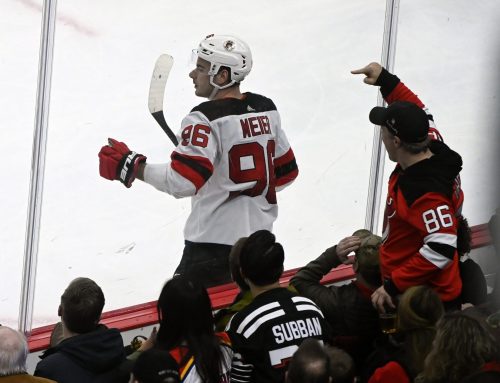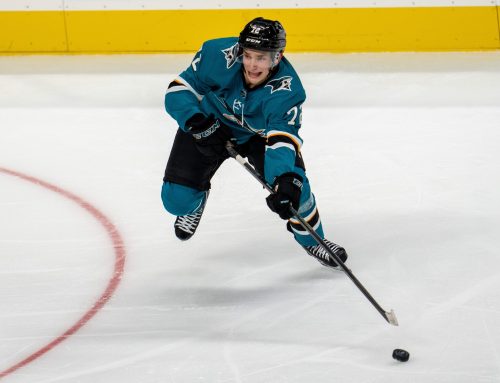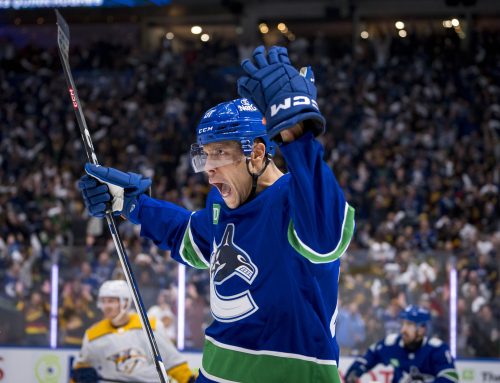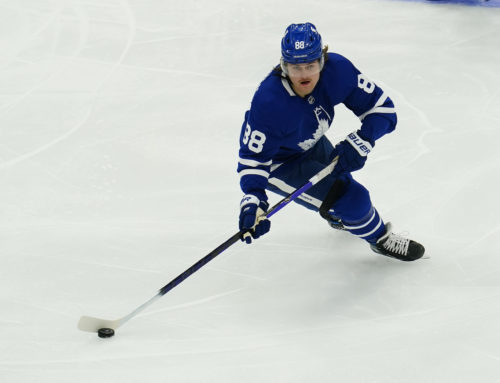Ramblings – A Game 7 disappointment and this season’s biggest PP movers (May 13)
Neil Parker
2016-05-13

A Game 7 letdown and the PP movers and shakers of the past year …
Game 7 between the Sharks and Predators was an unfortunate experience for us all. Or at least anyone looking to tune into an entertaining game.
The home team had won each game of the series, and Vegas had pegged San Jose as huge favorites.
It isn't fair to throw Shea Weber under the bus, and really, Pekka Rinne might deserve a pass, too. Nashville registered three shots after the first period and was in a 2-0 hole after 20 minutes.
Without checking the statistics, the eye test after 19 minutes made it very clear of the outcome.
There was way too much emphasis on blame. Weber and Rinne were both criticized. We all know they're veterans in a decline, but they're still capable players. Over focusing on their shortcomings potentially undermines the dominance of San Jose.
The Sharks showed up in their rank — or tank — and dominated, that's the story. Shea Weber isn't even the best defenseman on his own team, and Rinne is a middling goaltender. Don't blame them, celebrate San Jose.
***
Speaking of unfortunate happenings, a few hiccups in releasing the ramblings last night. Sorry to the night hawks and early risers for the late post.
I've got a Round 3 stat pack to release today to make up for it. I had planned to include it here, but I underestimated the time to compile the stats and put together the below Offensive PPPP Rankings stats and analysis.
***
Last week, the top-five risers and fallers in the Defensive PPPP Rankings from 2014-15 to 2015-16 were analyzed.
Today, we'll look at the biggest movers in the Offensive PPPP Rankings.
Here's a link, if you missed the look last week or need a refresher.
The most improved teams in the Offensive PPPP Rankings this season were the Anaheim Ducks, Buffalo Sabres, Chicago Blackhawks, Minnesota Wild and Nashville Predators. The Columbus Blue Jackets, Detroit Red Wings, Philadelphia Flyers, Tampa Bay Lightning and Vancouver Canucks were the biggest fallers in the rankings.

* Please note, the lower the ranking the better the power play. For example, 1 was the best power-play unit.
Anaheim Ducks
There isn't a lot of analysis needed here.
Anaheim's improvement in shooting percentage was notable. And digging deeper, Corey Perry jumped from 10.81 percent to 24.44, and Ryan Getzlaf climbed from 6.82 to 15.0. The growth for each resulted in their points per 60 minutes with the man advantage improving from 2.31 to 5.88 and 3.46 to 6.04, respectively.
It wouldn't be surprising to see Perry and Getzlaf land in the middle of the past two seasons next year, which would make Anaheim a slightly better-than-average club with the man advantage, and not an elite club.
However, there is always the potential of the supporting pieces stepping up.
Buffalo Sabres
The offseason upgrades were substantial, and with the maturation of Ramus Ristolainen added to Zach Bogosain's excellent finish, Buffalo's ascension was clientele related.
Ryan O'Reilly (22 power-play points) and Jack Eichel (20 PP points) provided a huge boost, and fewer minutes PP minutes for Matt Moulson and Brian Gionta can't be overstated.
Additionally, to put the 2014-15 club in perspective, Cody Hodgson played the fourth most minutes with the man advantage among Buffalo forwards. He had a 0.59 points per 60 minutes on the power play. Only Mason Raymond (0.52) and David Clarkson (0.51) were worse among players with at least 100 power-play minutes played. YUCK!
As Eichel, Sam Reinhart and Johan Larsson all improve their offensive games, the Sabres should continue to progress. A healthy Tyler Ennis would be a boost, too. Unfortunately, though, Ennis enters his age-27 season with concussion concerns and is likely past his offense prime.
Baking in extra production for the Buffalo power-play core isn't out of the question for 2016-17, especially Eichel and Ristolainen.
Chicago Blackhawks
To start, Patrick Kane's career year was padded by 16 goals and 19 assists with the man advantage. To what degree it was influenced by the addition of Artemi Panarin is debatable, but Panarin's 24 power-play points — eight PP goals — helped Chicago register the second-ranked 22.6 PP percentage.
The shooting percentage jump aligns with the jump in points per 60 minutes on the PP and the success rate. In most cases, a negative regression warning would be warranted, but significant decline might not be ahead here.
Elite talent can maintain seemingly unsustainable statistics, after all. Plus, Jonathan Toews, Duncan Keith and Brent Seabrook are familiar power-play comrades, and the continuity should help the success carry over into next season.
Still, a slight dip for Kane, Panarin and the power-play percentage should be counted on for 2016-17. Forecasting a slight dip doesn't equate to downgrade high-end talent, though. It just means being realistic with future results.
Columbus Blue Jackets
For all of Ryan Johansen's supposed shortcomings, he did score 11 power-play points through 38 games before the midseason trade last season.
He had seven goals and 19 assists with the man advantage during the 2014-15 campaign, so from a PP-per-game perspective, it wasn't a marked difference.
Additionally, the trade occurred roughly around the All-Star break, which Columbus entered with a 17.9 power-play percentage and finished the second half with a 16.3 percent clip. So, again, Johansen's impact wasn't significant/detrimental.
Noticeable, sure, but not the main reason for Columbus' plummet.
Jack Johnson and Nick Foligno were likely bigger factors.
Johnson played significant fewer minutes with the man advantage and after finishing with 6.02 points per 60 minutes on the power play in 14-15, he regressed to 2.55 last season. Foligno scored 11 power-play goals in 14-15, but failed to score a single PP goal this past season.
Personnel was also an issue, and while injuries were at play here, Ryan Murray led all Blue Jackets in PP ice time, and three forwards had more power-play minutess than Brandon Saad.
And, even though he didn't register a PP goal, Foligno did have the best P/60 mark (5.28), yet he played the sixth most PP minutes. Albeit he missed 10 games with injury.
Wrapping it up, Foligno and Johnson likely overachieved two years ago, Johansen's absence was a blow, and head coach John Tortorella isn't savvy.
Tortorella will likely continue to limit the power-play upside for the duration of his tenure, and his presence hinders the overall fantasy upside of Columbus skaters outside of the blocked shot column.
Detroit Red Wings
The 2014-15 league leaders fell to the middle of the pack this season, and the fall is similar to the rest with a negative regression in shooting percentage.
However, Detroit also received 24 fewer power-play opportunities after receiving a league-high 290 two years ago.
And while the metrics don't deal with volume, it is interesting to see the goals per 60 minutes with the man advantage not drop significantly in comparison to the power-play percentage and shooting percentage.
Aging and declining veterans was a significant contributor … or was it?
Pavel Datsyuk had six fewer power-play points in three more games, and Henrik Zetterberg had eight fewer PP points in five more games.
Yet, the regression from Gustav Nyquist and Tomas Tatar might have been more significant to the end results. Nyquist's P/60 dropped from 5.85 to 3.31 with the man advantage, and Tatar went from 5.35 to 4.15.
Plus, Dylan Larkin played the ninth most PP minutes among forwards.
Look for Larkin to take a notable-to-significant step forward next season with a larger power-play role. He hit the rookie wall with just 12 points through his final 32 games, and his year-end totals should keep his value down.
After all, most won't consider the lack of PP time and the difficulty of the transition from the short NCAA schedule to the NHL grind, and it could land Larkin in undervalued territory.
Minnesota Wild
Over the past two seasons, Minnesota's 9.62 shooting percentage last year was the lowest mark posted. They were prime candidates for positive regression, and the results checked out.
Ryan Suter was a huge beneficiary with nine more power-play points for 20 total last season, and Mikko Koivu improved from four goals to nine with the man advantage this year.
A few personnel changes proved beneficial, too.
Mikael Granlund received more power-play time and boosted his points per 60 minutes with the man advantage from 2.96 to 3.50, and Mathew Dumba scored 11 PP points with a 3.83 P/60.
Jared Spurgeon is likely being under utilized, though, as his 5.88 P/60 on the power play was a team high, but he played fewer minutes than Suter and Dumba.
Jason Pominville and Thomas Vanek, on the other hand, failed to improve their power-play numbers despite the team as a whole improving. That's a serious warning sign, if you needed another.
Nashville Predators
Shea Weber and Roman Josi moved the improvement needle, and the credit shouldn't shift away from the duo too far, if at all.
Weber returned 26 power-play points and a 6.57 points per 60 minutes with the man advantage this season compared to 15 PP points and 3.83 P/60 during the 2014-15 campaign.
Josi had 24 PP points and a 5.83 P/60 this year compared to 15 and 3.65 marks, respectively, during the 2014-15 season.
Filip Forsberg and James Neal showed modest improvement, and it is worth noting, Mattias Ekholm (3.23 P/60 on the PP) and Calle Jarnkrok (4.50) were strong contributors when given the opportunity.
Looking forward, in terms of talent, Josi, Forsberg and Ryan Johansen can carry a No. 1 power-play unit, especially with Weber teed up as the triggerman. There could be slight regression in the final numbers and underlying statistics, but another top-10 showing in 2016-17 is likely.
However, no one should be surprised if Nashville sits atop the power-play rankings next year.
Philadelphia Flyers
The fall from being elite with the man advantage to being average starts at the top with Claude Giroux and Jakub Voracek dropping exactly 10 power-play points each. The duo witnessed their points per 60 minutes with the man advantage fall from 8.36 to 5.48 and 7.20 to 5.26, respectively.
Giroux's P/60 on the power play was the highest mark among skaters with at least 50 minutes of power-play time in 2014-15, and Voracek ranked ninth. And, Wayne Simmonds also dropped from a 6.12 mark to 4.35.
Regression loomed.
The PP started slowly clicking at just 12.5 percent in October, and then trailed off to finish the season with a 14.3 mark in March before converting at 28.6 percent in April. And including April highlights the upside, after Philadelphia also posted a 20.9 success rate during January.
However, and interestingly, among defensemen with at least 100 PP minutes, Shayne Gostisbehere managed a 24th-ranked 4.78 P/60 with the man advantage, which could suggest the Flyers might have missed Mark Streit, at least to a degree.
After all, Streit posted a third-best 6.23 P/60 mark among defenseman who logged at least 100 minutes of power-play time during the 14-15 campaign.
Gostisbehere will be overrated next fall, and Giroux, Voracek and Simmonds will land somewhere between their 14-15 and 15-16 power-play production. There is room for a rebound here.
Judge accordingly.
Tampa Bay Lightning
This was another cut-and-dried case where the 2014-15 shooting percentage with the man advantage pulled the Lightning power play to an unrepeatable height, and in this past season, Tampa Bay posted a third-worst PP percentage (15.8 percent).
There is a smoke-and-mirrors angle here, though, too. The Lightning haven't been fully healthy or playing with their best roster at any point this season, playoffs included. And it could be argued the best power-play assets weren't properly utilized during the 2014-15 campaign, either.
What we're left with is an immensely talented group with an unknown degree of uncertainty for what is ahead. Seriously, there are far too many questions to adequately project what's in store for Tampa Bay.
We know Nikita Kucherov is an elite/near-elite offensive contributor. When healthy, Tyler Johnson and Victor Hedman are also strong. Steven Stamkos and Jonathan Drouin are question marks going forward, and Ondrej Palat and Alex Killorn are supporting pieces.
Anton Stralman is an excellent real-word defenseman, but his fantasy value is likely extended beyond his potential return because of his situation at this point. His role on the No. 1 unit could end at any point, and it would hurt his value significantly.
What we see in Round 3 of the playoffs and over the summer could speak louder about the 2016-17 Lightning than anything we've seen to this point, too.
Whoever Tampa Bay builds around going forward will have plenty of fantasy value, but they've got upcoming cap issues, too much talent and championship aspirations, so there are currently too many moving pieces to say anything more than expect improvement next year.
Vancouver Canucks
Is passing an option?
We all know the situation here, and improvement is highly unlikely. Henrik Sedin and Daniel Sedin still move the needle, especially with the man advantage, but the supporting cast is weak.
Yannik Weber's 3.02 points per 60 minutes with the man advantage topped all defenseman, and that doesn't cut it. It also sums up the situation well. A journeyman is the best offensive blueliner, and he can't consistently crack the lineup.
Bo Horvat was encouraging with a third-best 4.14 P/60, but he likely won't develop into a dominant PP producer. He put together a few hot stretches throughout the season, and with more power-play time and modest offensive growth, Horvat should flirt with 50 points.
Jake Virtanen, Sven Baertschi and Linden Vey could also see an uptick in results, and potentially Jared McCann. However, until the Sedins open up top offensive minutes, these are all supporting pieces with little fantasy value in most formats.
Further decline is ahead, but in points-only pools/formats, the Sedin twins could, at least potentially, come at a discount. Even die-hard truthers know Vancouver is set for a significant decline, but without any competition for prime offensive minutes, the twins will continue to be the top scorers.
***
Thanks for tuning in.





 TOR
TOR BOS
BOS DAL
DAL VGK
VGK EDM
EDM L.A
L.A COL
COL FLA
FLA T.B
T.B VAN
VAN NYR
NYR WPG
WPG
